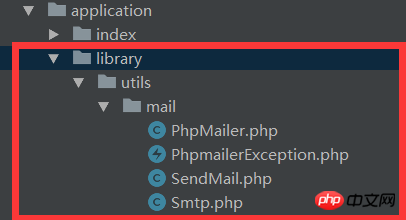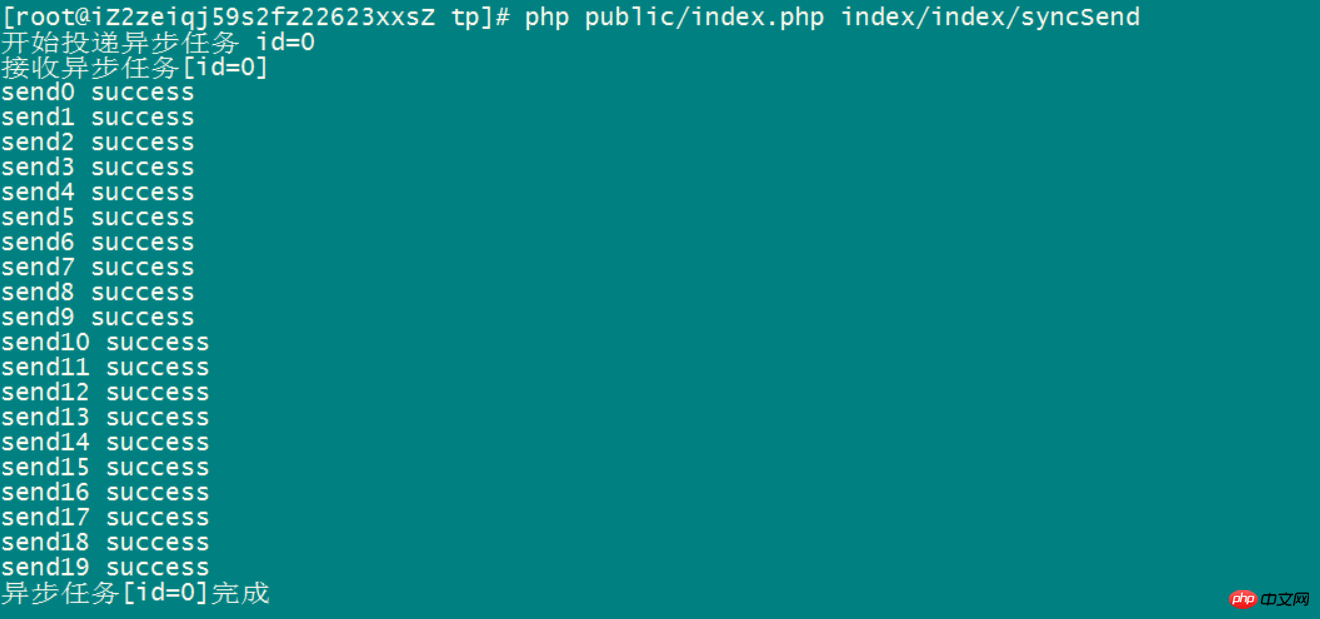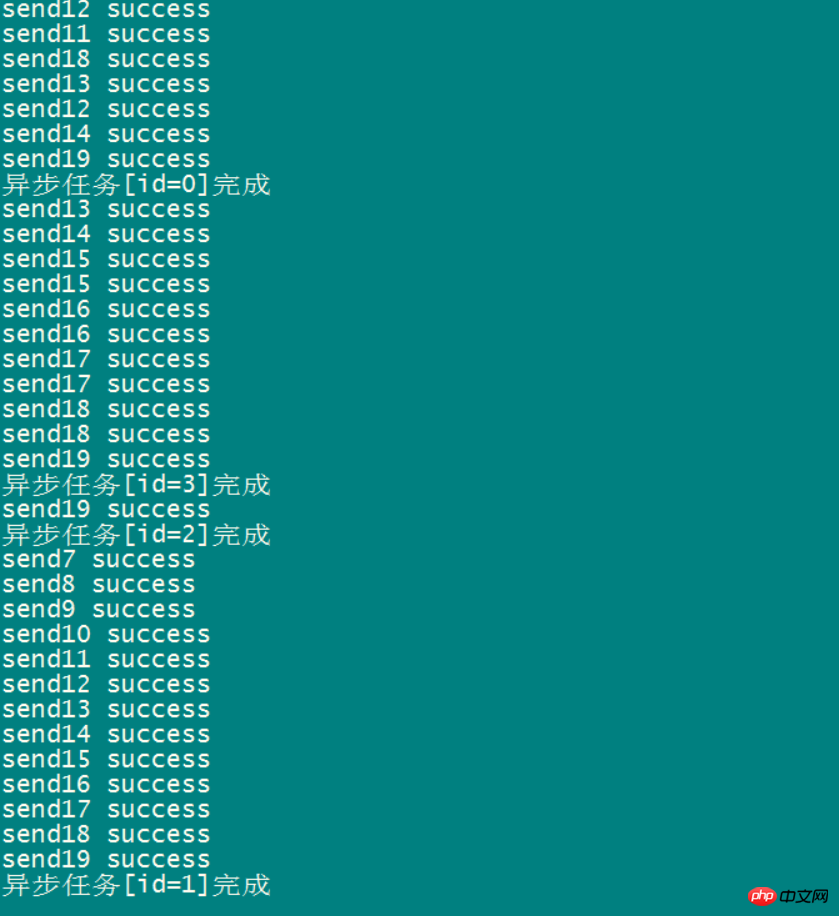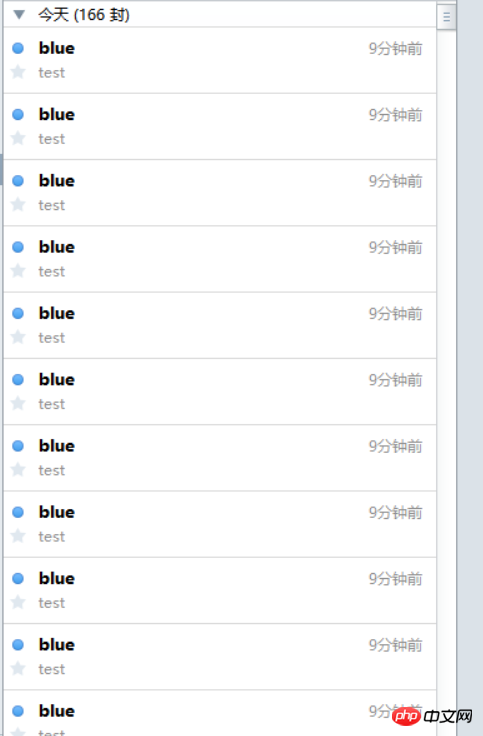 Backend Development
Backend Development
 PHP Tutorial
PHP Tutorial
 Implementation method of asynchronous mass mailing using thinkphp5 and swoole
Implementation method of asynchronous mass mailing using thinkphp5 and swoole
Implementation method of asynchronous mass mailing using thinkphp5 and swoole
This article mainly shares with you the implementation method of asynchronous mass mailing in thinkphp5 and swoole. I hope it can help you.
1. Environment description
Alibaba cloud centos7
thinkphp5.0.11
swoole2.0.8
2. tp implementation Email sending
Create the following file directory under the project:
where SendMail.php is the file we actually call to send emails. The following is the main code: The config configuration items in
namespace app\library\utils\mail;use app\library\utils\mail\PhpMailer;use app\library\utils\mail\Smtp;use think\Log;
error_reporting(E_STRICT);
date_default_timezone_set('Asia/Shanghai');class SendMail{ static function postmail($to,$subject = '',$body = ''){
$mail = new PhpMailer();
$mail->CharSet = config('mail.CharSet');
$mail->IsSMTP();
$mail->SMTPDebug = config('mail.SMTPDebug');
$mail->SMTPAuth = config('mail.SMTPAuth');
$mail->SMTPSecure = config('mail.SMTPSecure');
$mail->Host = config('mail.Host');
$mail->Port = config('mail.Port');
$mail->Username = config('mail.Username');
$mail->Password = config('mail.Password');
$mail->SetFrom(config('mail.From'), config('mail.Name'));
$mail->Subject = $subject;
$mail->MsgHTML($body);
$address = $to;
$mail->AddAddress($address, ''); if(!$mail->Send()) {
Log::write('send to '.$to.'error info:'.$mail->ErrorInfo); return false;
} else { return true;
}
}
}are placed in the config.php file under the project. The specific configuration content is as follows:
//邮箱设置
'mail'=>[ 'CharSet'=>'UTF-8', 'SMTPDebug'=>0,// 启用SMTP调试功能 0关闭
'SMTPAuth'=>true,// 启用 SMTP 验证功能
'SMTPSecure'=>'ssl',// 安全协议
'Host'=>'smtp.163.com',// SMTP 服务器
'Port'=>465,// SMTP服务器的端口号
'Username'=>'**********',// SMTP服务器用户名
'Password'=>'**********',// SMTP服务器密码
'From'=>'*********@163.com',// 发件人邮箱
'Name'=>'blue',// 发件人邮箱
]2.1
here We only implemented the demo sent by the SMTP protocol, so it was not very comprehensive and not very flexible at the packaging level. The other two files in the picture (PhpMailer.php and Smtp.php) are the core files of Phpmailer email sending class. In order to simplify the call, they are extracted. For detailed usage and parameter settings, you can refer to gayhub's usage instructions phpmailer
2.2 Notes
In this step, we need to pay attention to a few points: 1. Whether the account you set to send the email has enabled SMTP and find the corresponding security protocol and port number. 2. Whether the current server supports SMTP service, which is often affected by some socket functions. When encountering problems, we should set the SMTPDebug parameter to 1, and then debug carefully based on the debug information. 3. Some emails sent will be put into the trash, please check them carefully.
2.3 Call
to establish the following file directory structure: 
Call the method of sending emails in Index.php, the specific code is as follows
public function sendMail()
{
if(SendMail::postmail('937069176@qq.com','test','123'))
{ echo 'send success';
}else{
echo 'send fail';
}
}2.4 Call result

We can find an email we just sent in the trash can of QQ mailbox
3. Combine with swoole to achieve asynchronous mass sending
3.1 Install swoole
The detailed steps for swoole extension installation are available on the official website, so I won’t go into details. The swoole document portal
is installed After swoole, it is recommended to add swoole code prompts to your IDE, and configure the portal for the IDE to prompt swoole codes
3.2 Implement asynchronous mass sending
Let’s implement the asynchronous server first:
/**
* description:服务端
*/
public function syncSend(){
$serv = new \swoole_server('0.0.0.0',8082);
$serv->set(array('task_worker_num' => 4));
$serv->on('receive', function($serv, $fd, $from_id, $data) {
$task_id = $serv->task($data); echo "开始投递异步任务 id=$task_id\n";
});
$serv->on('task', function ($serv, $task_id, $from_id, $data) { echo "接收异步任务[id=$task_id]".PHP_EOL; for ($i = 0 ; $i<20;$i++){ if(SendMail::postmail('937069176@qq.com','test',$data)){ echo 'send'.$i.' success'."\n";
}else{ echo 'send'.$i.' fail'."\n";
}
}
$serv->finish('');
});
$serv->on('finish', function ($serv, $task_id, $data) { echo "异步任务[id=$task_id]完成".PHP_EOL;
});
$serv->start();
}On the server side, we used a loop of 20 to simulate mass sending. In fact, just change it to a different email address.
Next we implement the client
/**
* description:客户端
*/
public function index()
{
$client = new \swoole_client(SWOOLE_SOCK_TCP, SWOOLE_SOCK_SYNC);
$ret = $client->connect("127.0.0.1", 8082); if(empty($ret)){ echo 'error!connect to swoole_server failed';
} else {
$client->send('blue');//这里只是简单的实现了发送的内容
}
}3.3 Open the server
The CLI method must be used here, and we enter the root directory of the project.
Execution
netstat -apn | grep 8082
First monitor whether port 8082 is occupied. If it is occupied,
kill -9 PID(进程号)
Kill the process
Then we execute
php public/index.php index/index/syncSend
This The function of this command is to use cli mode to put our 8082 port in the listening state. And keep this terminal active so that we can view the sent results.
接着我们可以用CLI或者浏览器访问的方式来访问我们的客户端
php public/index.php index/index/index
当我们执行一次的时候客户端的时候,我们可以在服务端的终端看到屏幕上面出现如下的画面:

说明我们已经正常群发了。
下面,我们就来测试异步,因为163服务器会对IP进行检测,如果在某个时间发送也别频繁的话,会出现发送失败的情况,所以我们测试的时候,采用连续执行4次客户端的方式
下面是执行的结果:


从图中发送的顺序来看,我们可以很容易的判断,我们已经实现了异步的发送。
邮箱里面也接收到了刚刚发送的邮件。

4、后记~
swoole是一种想要熟悉和熟练使用的扩展,但是限于网络编程知识的不足,所以还是要多多测试和学习,demo中有不足的地方,还请指出。
The above is the detailed content of Implementation method of asynchronous mass mailing using thinkphp5 and swoole. For more information, please follow other related articles on the PHP Chinese website!

Hot AI Tools

Undresser.AI Undress
AI-powered app for creating realistic nude photos

AI Clothes Remover
Online AI tool for removing clothes from photos.

Undress AI Tool
Undress images for free

Clothoff.io
AI clothes remover

Video Face Swap
Swap faces in any video effortlessly with our completely free AI face swap tool!

Hot Article

Hot Tools

Notepad++7.3.1
Easy-to-use and free code editor

SublimeText3 Chinese version
Chinese version, very easy to use

Zend Studio 13.0.1
Powerful PHP integrated development environment

Dreamweaver CS6
Visual web development tools

SublimeText3 Mac version
God-level code editing software (SublimeText3)

Hot Topics
 PHP 8.4 Installation and Upgrade guide for Ubuntu and Debian
Dec 24, 2024 pm 04:42 PM
PHP 8.4 Installation and Upgrade guide for Ubuntu and Debian
Dec 24, 2024 pm 04:42 PM
PHP 8.4 brings several new features, security improvements, and performance improvements with healthy amounts of feature deprecations and removals. This guide explains how to install PHP 8.4 or upgrade to PHP 8.4 on Ubuntu, Debian, or their derivati
 7 PHP Functions I Regret I Didn't Know Before
Nov 13, 2024 am 09:42 AM
7 PHP Functions I Regret I Didn't Know Before
Nov 13, 2024 am 09:42 AM
If you are an experienced PHP developer, you might have the feeling that you’ve been there and done that already.You have developed a significant number of applications, debugged millions of lines of code, and tweaked a bunch of scripts to achieve op
 How To Set Up Visual Studio Code (VS Code) for PHP Development
Dec 20, 2024 am 11:31 AM
How To Set Up Visual Studio Code (VS Code) for PHP Development
Dec 20, 2024 am 11:31 AM
Visual Studio Code, also known as VS Code, is a free source code editor — or integrated development environment (IDE) — available for all major operating systems. With a large collection of extensions for many programming languages, VS Code can be c
 Explain JSON Web Tokens (JWT) and their use case in PHP APIs.
Apr 05, 2025 am 12:04 AM
Explain JSON Web Tokens (JWT) and their use case in PHP APIs.
Apr 05, 2025 am 12:04 AM
JWT is an open standard based on JSON, used to securely transmit information between parties, mainly for identity authentication and information exchange. 1. JWT consists of three parts: Header, Payload and Signature. 2. The working principle of JWT includes three steps: generating JWT, verifying JWT and parsing Payload. 3. When using JWT for authentication in PHP, JWT can be generated and verified, and user role and permission information can be included in advanced usage. 4. Common errors include signature verification failure, token expiration, and payload oversized. Debugging skills include using debugging tools and logging. 5. Performance optimization and best practices include using appropriate signature algorithms, setting validity periods reasonably,
 PHP Program to Count Vowels in a String
Feb 07, 2025 pm 12:12 PM
PHP Program to Count Vowels in a String
Feb 07, 2025 pm 12:12 PM
A string is a sequence of characters, including letters, numbers, and symbols. This tutorial will learn how to calculate the number of vowels in a given string in PHP using different methods. The vowels in English are a, e, i, o, u, and they can be uppercase or lowercase. What is a vowel? Vowels are alphabetic characters that represent a specific pronunciation. There are five vowels in English, including uppercase and lowercase: a, e, i, o, u Example 1 Input: String = "Tutorialspoint" Output: 6 explain The vowels in the string "Tutorialspoint" are u, o, i, a, o, i. There are 6 yuan in total
 How do you parse and process HTML/XML in PHP?
Feb 07, 2025 am 11:57 AM
How do you parse and process HTML/XML in PHP?
Feb 07, 2025 am 11:57 AM
This tutorial demonstrates how to efficiently process XML documents using PHP. XML (eXtensible Markup Language) is a versatile text-based markup language designed for both human readability and machine parsing. It's commonly used for data storage an
 Explain late static binding in PHP (static::).
Apr 03, 2025 am 12:04 AM
Explain late static binding in PHP (static::).
Apr 03, 2025 am 12:04 AM
Static binding (static::) implements late static binding (LSB) in PHP, allowing calling classes to be referenced in static contexts rather than defining classes. 1) The parsing process is performed at runtime, 2) Look up the call class in the inheritance relationship, 3) It may bring performance overhead.
 What are PHP magic methods (__construct, __destruct, __call, __get, __set, etc.) and provide use cases?
Apr 03, 2025 am 12:03 AM
What are PHP magic methods (__construct, __destruct, __call, __get, __set, etc.) and provide use cases?
Apr 03, 2025 am 12:03 AM
What are the magic methods of PHP? PHP's magic methods include: 1.\_\_construct, used to initialize objects; 2.\_\_destruct, used to clean up resources; 3.\_\_call, handle non-existent method calls; 4.\_\_get, implement dynamic attribute access; 5.\_\_set, implement dynamic attribute settings. These methods are automatically called in certain situations, improving code flexibility and efficiency.





